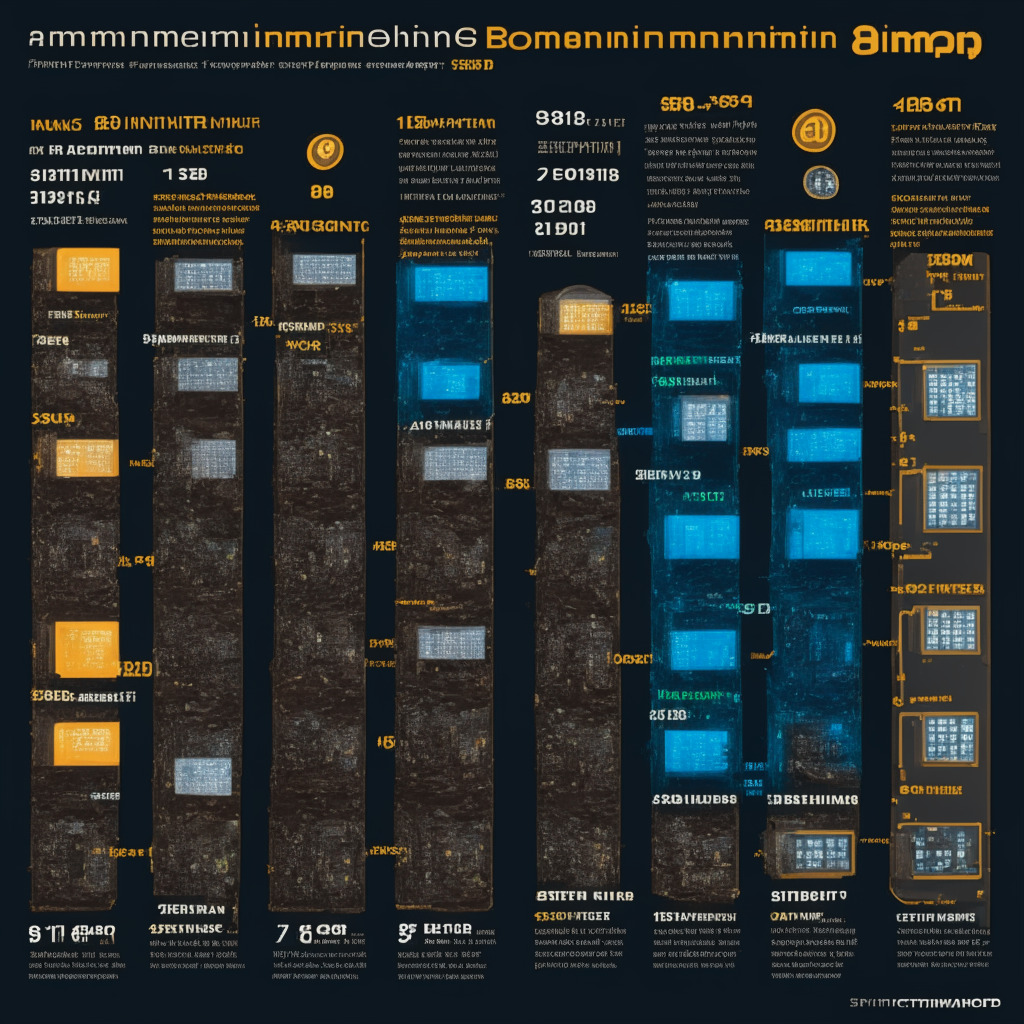“Crypto-related employment has spiked approximately 160% since 2019, expecting to reach 190,000 by 2023. Although the employment surge has faced challenges like several layoffs, the trend demonstrates the sector’s attractivity and continued potential for job opportunities despite volatility.”
Search Results for: tether
Aave’s GHO Stablecoin Accomplishes $2.5 Million Minting in Two Days: An Insightful Analysis
Aave’s new stablecoin GHO, backed by the Ethereum network, generated $2.5 million within 48 hours of its launch. It operates under the governance of the Aave DAO community and offers robustness and dynamism through over-collateralized assets. With the release of GHO, Aave’s total locked value increased significantly, highlighting the platform’s success and market growth.
Lightning Strikes Binance: Speedy Transactions vs. Increased Complexity and a New Stablecoin on the Block
“Cryptocurrency exchange Binance has successfully incorporated the Bitcoin Lightning Network, enhancing Bitcoin transactions by enabling faster, cheaper off-chain transaction channels. In related news, decentralized finance protocol Aave has launched GHO, a dollar-pegged stablecoin, introducing a transparent, verifiable, over-collateralized asset into the crypto market.”
Unveiling the Fir Tree’s Digital Asset Opportunities Fund: Turning Crypto Turmoil into Dividends
New York hedge fund, Fir Tree Partners, is launching the Fir Tree Digital Asset Opportunities Fund to capitalize on opportunities within the complex digital asset markets. The move, set for August 1, comes despite the firm’s history of risky crypto engagements and the notable risks associated with investing in distressed assets.
The Rise and Fall of Celsius Network: A Tale of Regulatory Oversight in Cryptocurrency
“The downfall of Celsius Network, a lending platform founded by Alex Mashinsky, highlights the challenges blockchain and regulatory concerns pose to the crypto industry. Misleading statements, market instability, halted withdrawals, and eventual bankruptcy underline the importance of due diligence and ongoing regulatory oversight in the cryptocurrency ecosystem.”
Bitget’s Staggering $1.44 Billion Reserve Ratio: Financial Fortitude or Overcautious Strategy?
Crypto exchange Bitget declares a debt-free status and remarkable reserves totalling $1.44 billion, exceeding the industry-standard backing with a reserve ratio of 223%. Built through transaction fee profits and returns from investments, Bitget seeks to maintain transparency and reinforce trust by issuing monthly proof-of-reserve statements. The exchange also initiates a crypto lending program, enabling users to maximize investment possibilities.
Crypto Regulation Spotlight: Mashinsky’s Detainment Fuels Debate on SEC Oversight and CFTC Role
Alex Mashinsky’s detainment on allegations of wire fraud, securities fraud, and price manipulation intensifies discussions on crypto regulation. Mashinsky’s case, alongside a ruling favoring Ripple, could have significant implications for platforms like Binance, Coinbase, and Bittrex that have faced SEC accusations. The situation underscores the need for a comprehensive regulatory regime to counter potential frauds in the crypto market.
Coinbase Revolutionizes Crypto with Encrypted Messaging: A Trend or Tryst?
“Coinbase announces its self-custody wallet will soon double as an encrypted messaging service, powered by XMTP—a web3-based decentralized communications network. This enables users to interact differently with their wallets, facilitating secure, personal transactions and extending the realm of cryptocurrencies.”
The Rise and Uncertainty of Centralized Stablecoins: Balancing Transparency and Dependence
Centralized stablecoins, stabilizing their price against another asset like the U.S dollar, account for 75% of all transactions on centralized crypto exchanges, with TrueUSD (TUSD) and Tether’s USDT taking significant shares. However, amid growth, controversies and transparency issues pose challenges and risks, demonstrating the crypto market’s vulnerability. The future of such stablecoins depends on addressing these vulnerabilities and embracing transparency.
Navigating the Tides: Recent Market Shifts and What They Mean for the Blockchain Future
“A remarkable shift in the crypto markets kindled interest in AI-related tokens following Elon Musk’s announcement of a new AI company, xAI. Cryptocurrencies’ ecosystem receives another boost as Telegram expands their chat-centric payments system suggesting a significant stride in mainstream crypto usage.”
Wallet Pay: Shaping the Future of In-App Crypto Payments or a Regulatory Nightmare?
Telegram’s wallet bot, Wallet, introduces a new feature, Wallet Pay, enabling encrypted in-app transactions supporting cryptocurrencies such as Bitcoin, Tether, and Toncoin. The feature is available globally, but businesses must navigate their own local crypto regulations before adopting Wallet Pay.
Global Digital Currency Race: Stablecoins Threat or CBDCs Safety?
“The race for global digital currency dominance has stablecoins and Central Bank Digital Currencies (CBDCs) in the lead. However, Rabi Sankar, Deputy Governor of the Reserve Bank of India, warns that stablecoins could pose significant policy sovereignty risks for certain nations.”
Unearthing Bitcoin’s Energy Efficiency: A Tale of Progress and Ongoing Challenges
“Coinmetrics reports highlight a noteworthy enhancement in Bitcoin network’s energy efficiency by about 60% since July 2018, due to the arrival of superior, more efficient machines. Additionally, CoinShares’ research indicates that a substantial 74.1% of Bitcoin mining energy originates from renewable sources.”
Significant Improvements in Bitcoin’s Energy Efficiency: Promise or Peril?
Bitcoin’s energy efficiency has improved by about 60% since 2018 due to more efficient mining systems. This gain in efficiency is critical as concerns rise about the environmental impact of Bitcoin mining activities. This progress is matched with a trend towards sustainable energy sources, with 74.1% of Bitcoin’s mining power now coming from renewable energy sources.
Bank of England Governor’s Stance on Crypto: An Unsettling Future or Undeniable Potential?
“Governor Andrew Bailey of the Bank of England expressed skepticism towards cryptocurrencies, particularly Bitcoin, citing their volatile nature. However, he sees potential in enhanced forms of digital money. Despite concerns over the stability of stablecoins, the bank is exploring options for modernizing through the potential introduction of retail Central Bank Digital Currency payments.”
Navigating the Roaring Tides: The Confluence of Stablecoins, CBDCs and China’s Economic Strategy
Jeremy Allaire, CEO of Circle, suggests that a Yuan-backed stablecoin could aid Beijing’s goal of widespread acceptance of the Chinese Yuan. However, he notes that strict economic policies and capital controls could be potential obstacles. Allaire highlights that despite the challenges, stablecoins have proven beneficial for overseas monetary remittances, particularly for Chinese firms.
Unraveling the Multichain Mystery: Inside Job or Outsider Exploit?
“Cryptocurrency enthusiasts were alarmed by reports of Multichain’s suspicious withdrawals and possible internal fraud or “rug pull”. Questions arise over its administration’s integrity and security, highlighting the need for robust security measures, comprehensive internal protocols, and regulatory oversight in cryptocurrency platforms.”
Bitcoin Resilience and Binance.US Liquidity Challenges: A Study in Crypto Market Dynamics
Bitcoin continues to show signs of positive decentralization with over one million wallets each holding at least one Bitcoin. However, Binance.US faces liquidity challenges, with a significant discount on Bitcoin and Tether (USDT) trades due to suspended fiat pipelines. The current market dynamics highlight intriguing movements in future blockchain markets and technologies.
Ethereum’s New Improvement Proposal: A Solution for Secure Token Bridging or Added Complexity?
Ethereum Improvement Proposal (EIP-7281), co-authored by Arjun Bhuptani, aims to standardize bridging of tokens between networks. This new protocol seeks to minimize risks like the recent Multichain incident by moving token ownership from bridges to issuers, thus limiting possible losses from bridge security breaches.
Navigating the MiCA Legislation: Impacts on Private Stablecoins and the Future of Crypto Regulation
The European Union enacted the Markets in Crypto-Assets (MiCA) legislation, sparking controversy with a daily 200 million euros transaction cap for private stablecoins. This is meant to protect investors from large-scale stablecoin failures which could impact traditional financial systems. However, critics argue it could stifle innovation within the crypto landscape.
Cybersecurity in the Crypto World: Unraveling the Challenges and Implementing Countermeasures
“In an ever-evolving crypto world, cybersecurity is a priority. The Bank For International Settlements (BIS) has proposed a seven-point plan intended to fortify digital assets, mainly central bank digital currencies (CBDCs), against cyber threats due to their complex systems, large attack surfaces, and numerous potential points of failure.”
Unveiling The Future of Cryptocurrencies: Stability, Regulations, and Global Adoption of Digital Currencies
“The crypto market, reflected by Bitcoin’s and Ether’s stability, faces possible changes due to U.S. inflation figures, SEC’s scrutiny of Coinbase, the potential proliferation of retail central bank digital currencies (CBDCs), and fluctuating on-exchange liquidity at Huobi. This complex ecology requires caution, curiosity, and adaptability.”
Ethereum’s Scalability Solutions: A Benchmark for Bitcoin or a Cause for Unique Pathways?
“Ethereum’s co-founder, Vitalik Buterin, believes that Bitcoin’s network needs to experiment with scalable solutions like zero-knowledge (ZK) rollups to grow beyond just a payment network. In contrast to Ethereum’s active experimentation with layered solutions, Bitcoin’s scalability focuses on its layer-2 solution- the Lightning Network.”
Switzerland’s Transformation: From Banking Secrecy to Bitcoin Adoption
“Switzerland is becoming a hub for Bitcoin adoption, thanks to its cultural emphasis on sovereignty and financial privacy. As Bitcoin gains mainstream acceptance, politicians and financial commissioners are becoming Bitcoiners. However, transitioning to a digital currency-powered economy poses challenges in a nation with a robust financial infrastructure.”
Marathon Digital’s Mining Decline Vs the Foul Play in Crypto Markets: A Tale of Ups and Downs
“Marathon Digital’s Bitcoin mining yield declined due to adverse weather and lower transaction fees, despite a 599% increase from June 2022. However, Bitcoin miners reportedly earned $184 million in Q2 2023. Yet, hacking risks and operational challenges linked to climate change remind us of the industry’s instability, insisting on continued vigilance and resilience.”
Deciphering Bitcoin’s Emerging Independence: Is It a Break from Traditional Market Gravitational Pull?
“Bitcoin’s performance correlation with U.S. stock markets has dropped to near zero, the lowest in two years. This change may indicate Bitcoin’s growing decoupling from broader investing sentiment. Factors contributing to this include the proposals for Bitcoin exchange-traded funds (ETFs) by major companies like BlackRock and Fidelity. Despite this decoupling, Bitcoin isn’t immune to worldly economic influences.”
The Double-Edged Sword of Crypto: The Financial Paradox Post-Voyager’s Bankruptcy
The bankruptcy of crypto platform Voyager in 2022 reveals the challenges of the crypto world. Regulatory obligations can be financially strenuous, with Voyager’s downfall and legal costs reaching $16.4 million. Despite offering potential for innovation and speculation, the crypto space’s volatility and regulatory complexities present hard-to-ignore challenges for the future.
Blockchain and Counterterrorism: Binance, Israel, and the Fight against Crime in Crypto World
“Binance partnered with Israel’s Ministry of Defense to counter terrorism financing and seized millions in cryptocurrency linked to Iran’s Quds Force. Despite highlighting blockchain’s potential in enhancing global security, this mission reveals the significant illicit activity within the cryptocurrency landscape.”
Lacoste Leap into NFTs: Innovation or Hazard to Fashion and Environment?
“Lacoste ushers into non-fungible tokens, creating an interactive place for its UNDW3 community via virtual collectibles. It starts with 11,212 PFP NFTs, weaving an immersive customer experience. This innovative approach invites customer participation, transforming NFTs into UNDW3 cards which open up creative sessions, contests, games, and interactive dialogues.”
Regulation Wars: Coinbase’s Showdown with SEC and Binance’s License Denial in Germany
“Crypto-exchange Coinbase faces the U.S. Securities and Exchange Commission (SEC) over allegations some cryptocurrencies offered are unregistered securities. Meanwhile, Binance encounters difficulties getting a custody license from the German Federal Financial Supervisory Authority. With this, the saga of crypto regulation continues highlighting the tension between investor protection and market innovation.”
Binance Reverses Privacy Coin Delisting: Unpacking the Decision and Industry Implications
Binance reverses its decision to delist privacy coins in some EU nations, citing revised classification for compliance with EU regulations. The exchange must now follow regulations requiring transaction monitoring for listed coins. Binance’s approach raises questions about its decision-making process and response to regulatory requirements.
Beware of Fake DeFi Tokens: Protecting Your Wallet from Scams and Address Poisoning
Tres Finance has warned the community about scams involving fake tokens designed to mimic legitimate transactions, targeting wallets containing large amounts of stablecoins. Scammers create similar-looking wallet addresses and tokens, putting users at risk of sending transactions to scammers.































